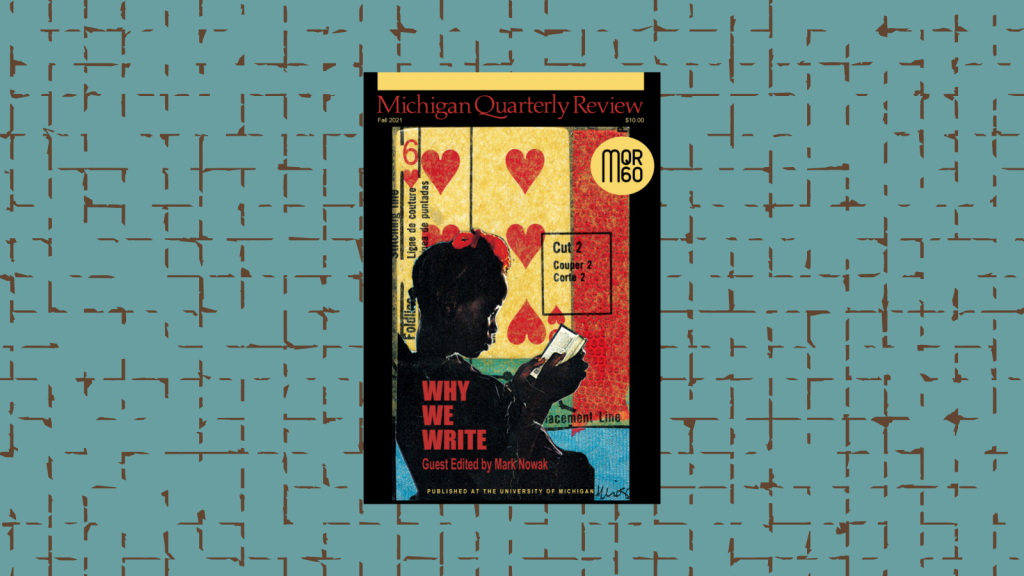Krista Franklin is a writer and visual artist, the author of Too Much Midnight (Haymarket Books, 2020), the artist book Under the Knife (Candor Arts, 2018), and the chapbook Study of Love & Black Body (Willow Books, 2012). She is a Helen and Tim Meier Foundation for the Arts Achievement Awardee, and a recipient of the Joan Mitchell Foundation Painters and Sculptors Grant. Her visual art has been exhibited at Poetry Foundation, Konsthall C, Rootwork Gallery, Museum of Contemporary Photography, Studio Museum in Harlem, Chicago Cultural Center, National Museum of Mexican Art, and the set of 20th Century Fox’s Empire. She has been published in Poetry, Black Camera, The Offing, Vinyl, and a number of anthologies and artist books.
The cover piece is titled R.I.F (Reading is Fundamental) and it features a child reading. What are some books that formed your foundation as a reader when you were young? Where do they surface in your practice as a writer and artist today?
A few books that formed my foundation as a young reader are The Outsiders by S.E. Hinton, and the novels of Judy Blume made a big impact on me in my youth. As a very young child, the books of Dr. Seuss were favorites. I was also a huge fan of Encyclopedia Brown chapter books and Nancy Drew stories; however, I was always an avid and voracious reader so pretty much whatever captured my eye at the library was getting checked out.
The Fall 2021 issue is entitled “Why We Write” and is inspired by George Orwell’s 1947 essay “Why I Write.” In the essay Orwell breaks down his motivations for writing into four distinct categories: sheer egoism, aesthetic enthusiasm, historical impulse, and political purpose. How would you map your own motivations as a writer?
I believe that motivations shift due to a number of different circumstances in a writer’s life. Certainly I’ve written through and been inspired by all the motivations Orwell mentions at different times and periods in my life. My current predominant motivation for writing at this point in my career and life is transformation. Internal transformation.
A lot of the work in the issue deals with the way the act of writing has changed for many during the pandemic and the political upheavals and possibilities of the moment. In your Dia: Dispatch you write about a shifting and, perhaps, fraught relationship to time during these days and months. Can you talk more about how the last year has altered your practice?
If the past year has altered anything about my practice, I am certainly too close to it to see it. If anything has been altered, it’s that activity has increased around and about the work. In many ways, the momentum of my practice has increased; it’s busier for me now than pre-pandemic. But frankly, I think I’m too close and too inside of it to know what’s been altered at this point. Ask me this same question five years from now and maybe I’ll have better insight.
Another major theme of the issue (and of the interviews we are featuring in the “Celebrating Writers in Our Community” series) has been the “we” in “Why We Write.” We have co-written and collaboratively translated pieces, erasures, and collages. Can you share a little about the role of collaboration, community, and conversation in your work?
This is a question that I’ve answered several times in many different places. I don’t believe that one can be a thriving artist and/or writer without the support, communion, and love of community; and community can take many different forms. My practice is interdisciplinary and dynamic and requires the minds, expertise, idea-exchange, and sometimes labor of a lot of other individuals who are also thriving in their own fields and practices. A book is not just the endeavor of the writer. There are many individuals who go into creating a book (editors, designers, publishers, printers, readers, etc). There are many individuals who contribute to creating an album or a performance. Community and collaboration are so embedded in the art of making art that often people don’t even recognize it or acknowledge it.
Your remarkable new book, Too Much Midnight, was released by Haymarket Books in 2020 and R.I.F (Reading is Fundamental) appeared on the cover of your first chapbook, Study of Love & Black Body, in 2012. How have your writerly preoccupations and questions changed (or remained unchanged) since your first book?
There are clear through lines and preoccupations from my chapbook Study of Love & Black Body to the most recent book Too Much Midnight, and the titles of the projects are big clues to what some of those preoccupations may be. I’m grappling with many of the same concepts in at least three of my books to date. Currently I don’t have any writerly preoccupations. It isn’t uncommon for me to go long stretches of time without writing anything beyond lists or emails. My relationship with writing is a life-long relationship, and in any long-term relationship there are periods of quiet or silence or dormancy. These periods of so-called silence are not an anomaly or a problem or a “block.” They’re a natural part of my writing process. So with that said, I will have a better grasp on whether or not my writerly preoccupations have changed when I begin writing again. I’ll have to let you know when I get there.
What is next for you?
Lunch. 🙂






